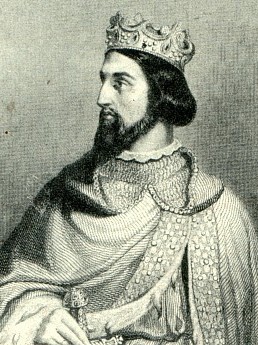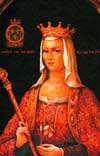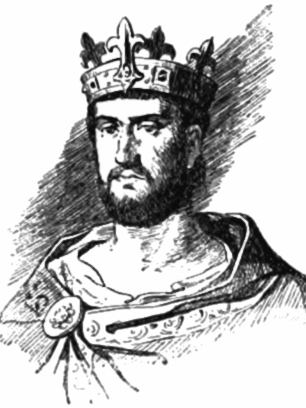Melisende of Jerusalem (1105 – 11th September 1161) was Queen of Jerusalem from 1131 to 1152, and regent for her son between 1153-1161 while he was on campaign. She was the eldest daughter of King Baldwin II of Jerusalem, and the Armenian princess Morphia of Melitene. She was named after her paternal grandmother, Melisende of Montlhery, wife of Hugh I, Count of Rethel. She had three younger sisters: Alice, princess of Antioch; Hodierna, countess of Tripoli; and Ioveta, abbess of St. Lazarus in Bethany. Hodierna's daughter, Melisende of Tripoli, was named in honor of the queen.
Inheritance
Jerusalem had recently been conquered by Christian Franks in 1099 during the First Crusade, and was ruled by a dynasty originally from the County of Rethel in France. Melisende was the heir of this dynasty, and was designated her father's successor before 1129. Women who inherited territory usually did so because war and violence brought many men to premature death, and women who were recognized as queen regnant rarely exercised their authority. Contemporaries of Melisende who did rule, however, included Urraca of Castile (1080 – 1129), Empress Matilda (1102 – 1169), and Eleanor of Aquitaine (1121 – 1204).
During her father's reign Melisende was styled filia regis et regni Jerosolimitani haeres ("daughter of the king and heir of the kingdom of Jerusalem") and took precedence above other nobles and Christian clergy in ceremonial occasions. Increasingly she was associated with her father on official documents, including in the minting of money, granting of fiefdoms and other forms of patronage, and in diplomatic correspondence. Baldwin raised his daughter as a capable successor to himself and Melisende enjoyed the support of the Haute Cour, a kind of royal council comprising the nobility and clergy of the realm.
However, Baldwin also thought that he would have to marry Melisende to a powerful ally, one who would protect and safeguard Melisende's inheritance as Queen and her future heirs. His intention was for a consort for his daughter, not a de jure uxoris king. Baldwin chose Fulk V, Count of Anjou, a renowned crusader and military commander, and in the future the paternal grandfather of Henry Plantagenet (Fulk's son of previous marriage, Geoffrey was in these same years married to Empress Matilda, Henry I of England's designated heir as England's next Queen regnant). Throughout the negotiations Fulk insisted on being joint ruler with Melisende. Baldwin acquiesced to these demands as Fulk was relatively rich (even for a crusader) and would bring troops and much military experience with him in defense of Jerusalem. Melisende bore a son and heir in 1130, the future Baldwin III. As an indication of Baldwin II's intentions to make Melisende sole queen and to strengthen her position, he designated Melisende as guardian for the young Baldwin, excluding Fulk altogether.
When Melisende became queen, her authority was based on hereditary and civil law, as William of Tyre wrote reseditque reginam regni potestas penes dominam Melisendem, Deo amabilem reginam, cui jure hereditario competebat ("the rule of the kingdom remained in the power of the lady queen Melisende, a queen beloved by God, to whom it passed by hereditary right").
After Baldwin II's death in 1131, Melisende and Fulk ascended to the throne as joint rulers. However, with the aid of his crusader knights Fulk excluded Melisende from granting titles and other forms of patronage, and publicly dismissed her authority. This treatment of their Queen irritated the members of the Haute Cour, whose own positions would be eroded if Fulk continued to dominate the realm.
Palace intrigue
The estrangement between husband and wife was a convenient political tool that Fulk used in 1134 when he accused Hugh II of Le Puiset, Count of Jaffa, of having an affair with Melisende. Hugh was the most powerful baron in the kingdom, and devotedly loyal to the memory of Baldwin II. This loyalty now extended to Melisende, though Hugh, by strict male succession, held a better claim to the throne. Hugh was a cousin of Melisende, and also a member of the royal family. Contemporary sources, such as William of Tyre, discount the infidelity of Melisende and instead point out that Fulk overly favoured newly arrived Frankish crusaders from Anjou over the native nobility of the kingdom. Had Melisende been guilty the church and nobility likely would not have later rallied to her cause.
Hugh allied himself with the Muslim city of Ascalon, and was able to hold off the army set against him. He could not maintain his position indefinitely, however. His alliance with Ascalon cost him support at court. The Patriarch negotiated lenient terms for peace, and Hugh was exiled for three years. Soon thereafter an unsuccessful assassination attempt against Hugh was attributed to Fulk or his supporters. This was reason enough for the queen's party to openly challenge Fulk, as Fulk's unfounded assertions of infidelity was a public affront that would damage Melisende's position entirely.
Through what amounted to a palace coup, the queen's supporters overcame Fulk, and from 1135 onwards Fulk's influence rapidly deteriorated. One historian wrote that Fulk's supporters "went in terror of their lives" in the palace. William of Tyre wrote that Fulk "did not attempt to take the initiative, even in trivial matters, without [Melisende's] knowledge". Husband and wife reconciled by 1136 and a second son, Amalric, was born. When Fulk was killed in a hunting accident in 1143, Melisende publicly and privately mourned for him.
Melisende's victory was complete. Again she is seen in the historical record granting titles of nobility, fiefdoms, appointments and offices, granting royal favours and pardons and holding court. Of Melisende, William of Tyre wrote "reseditque reginam regni potestas penes dominam Melisendem, Deo amabilem reginam, cui jure hereditario competebat." Melisende was no mere regent-queen for her son Baldwin III, but a Queen Regnant, reigning by right of hereditary and civil law.
Patroness of the church and arts
Melisende enjoyed the support of the church throughout her lifetime; from her appointment as Baldwin II's successor, throughout the conflict with Fulk, and later when Baldwin III would come of age. In 1138 she founded the large convent of St. Lazarus in Bethany where her younger sister Ioveta would rule as abbess. In keeping with a royal abbey, Melisende granted the convent the fertile plains of Jericho. Additionally, the queen supplied rich furnishings and liturgical vessels, so that it would not be in any way inferior to religious houses for men. According to author and historian Bernard Hamilton, Melisende also gave
"large endowments to the Holy Sepulchre, our Lady of Josaphat, the Templum Domini, the order of the Hospital, the leper hospital of Saint Lazarus, and the Praemonstratensians of Saint Samuel's."
Sometime between 1131 and 1143, the queen received the Melisende Psalter. It has been argued that the Psalter was given as a gift from Fulk after their dispute and alleged infidelity surrounding Hugh. The reason for this is the Falcon that is engraved into the ivory back cover, which is a word-play on the word Fulk. Though influenced by Byzantine and Italian traditions in the illuminations, the artists who contributed to it had a unique and decidedly 'Jerusalem style'. The historian Hugo Buchtal wrote that
"Jerusalem during the second quarter of the twelfth century possessed a flourishing and well-established scriptorium which could, without difficulty, undertake a commission for a royal manuscript de grand luxe".
Second Crusade
In 1144 the Crusader state of Edessa was besieged in a border war that threatened its survival. Queen Melisende responded by sending an army led by constable Manasses of Hierges, Philip of Milly, and Elinand of Bures. Raymond of Antioch ignored the call for help, as his army was already occupied against the Byzantine Empire in Cilicia. Despite Melisende's army, Edessa fell.
Melisende sent word to the Pope in Rome, and the west called for a Second Crusade. The crusader expedition was led by French King Louis and the German Emperor Conrad III. Accompanying Louis was his wife Eleanor of Aquitaine, with her own vassal lords in tow. Eleanor had herself been designated by her father, William X, to succeed him in her own right, just as Melisende had been designated to succeed her father.
During the Crusader meeting in Acre in 1148 the battle strategy was planned. Conrad and Louis advised 16-year old Baldwin III to attack the Muslim city-state of Damascus, though Melisende, Manasses, and Eleanor wanted to take Aleppo, which would aid them in retaking Edessa. The meeting ended with Damascus as their target. Damascus and Jerusalem were on very good diplomatic terms and there was a peace treaty between them. The result of this breach of treaty was that Damascus would never trust the Crusader states again, and the loss of a sympathetic Muslim state was a blow from which later monarchs of Jerusalem could not recover. After 11 months Eleanor and Louis departed for France, ending the Second Crusade.
Mother and son
Melisende's relationship with her son was complex. As a mother she would know her son and his capabilities, and she is known to have been particularly close to her children. As a ruler she may have been reluctant to entrust decision making powers to an untried youth. Either way there was no political or social pressure to grant Baldwin any authority before 1152, even though Baldwin reached majority in 1145. Baldwin III and Melisende were jointly crowned as co-rulers on Christmas Day, 1143. This joint crowning was similar to Melisende's own crowning with her father in 1128, and may have reflected a growing trend to crown one's heir in the present monarch's lifetime, as demonstrated in other realms of this period.
Baldwin grew up to be a capable, if not brilliant, military commander. By age 24 however, Baldwin felt he could take some responsibility in governance. Melisende had hitherto only partially associated Baldwin in her rule. Tension between mother and son mounted between 1150 and 1152, with Baldwin blaming Manasses for alienating his mother from him. The crisis reached a boiling point early 1152 when Baldwin demanded the patriarch Fulcher to crown him in the Holy Sepulchre, without Melisende present. The Patriarch refused. Baldwin, in protest, staged a procession in the city streets wearing laurel wreaths, a kind of self-crowning.
Baldwin and Melisende agreed to put the decision to the Haute Cour. The Haute Cour decided that Baldwin would rule the north of the kingdom and Melisende the richer Judea and Samaria, and Jerusalem itself. Melisende acquiesced, though with misgivings. This decision would prevent a civil war but also divide the kingdom's resources. Though later historians criticized Melisende for not abdicating in favor of her son, there was little impetus for her to do so. She was universally recognized as an exceptional steward for her kingdom, and her rule had been characterized as a wise one by church leaders and other contemporaries. Baldwin had not shown any interest in governance prior to 1152, and had resisted responsibility in this arena. The Church clearly supported Melisende, as did the barons of Judea and Samaria.
Despite putting the matter before the Haute Cour, Baldwin was not happy with the partition any more than Melisende. But instead of reaching further compromise, within weeks of the decision he launched an invasion of his mother's realms. Baldwin showed that he was Fulk's son by quickly taking the field; Nablus and Jerusalem fell swiftly. Melisende with her younger son Amalric and others sought refuge in the Tower of David. Church mediation between mother and son resulted with the grant of the city of Nablus and adjacent lands to Melisende to rule for life, and a solemn oath by Baldwin III not to disturb her peace. This peace settlement demonstrated that though Melisende lost the "civil war" to her son, she still maintained great influence and avoided total obscurity in a convent.
Retirement
By 1153 son and mother had been reconciled. Since the civil war, Baldwin had shown his mother great respect. Melisende's connections, especially to her sister Hodierna, and to her niece Constance of Antioch, meant that she had direct influence in northern Syria, a priceless connection since Baldwin had himself broken the treaty with Damascus in 1147.
As Baldwin III was often on military campaigns he realized he had few reliable advisers. From 1154 onwards she is again associated with her son in many of his official public acts. In 1156 she concluded a treaty with the merchants of Pisa. In 1157, with Baldwin on campaign in Antioch, Melisende saw an opportunity to take el-Hablis, which controlled the lands of Gilead beyond the Jordan. Also in 1157, on the death of patriarch Fulcher, Melisende, her half-sister Sibylla of Flanders, and Ioveta the Abbess of Bethany, had Amalric of Nesle appointed as patriarch of Jerusalem. Additionally, Melisende was witness to her son Amalric's marriage to Agnes of Courtenay in 1157. In 1160 she gave her assent to a grant made by her son Amalric to the Holy Sepulchre, perhaps on the occasion of the birth of her granddaughter Sibylla to Agnes and Amalric.
Death
In 1161 Melisende had what appears to be a stroke. Her memory was severely impaired and she could no longer take part in state affairs. Her sisters, the countess of Tripoli and abbess of Bethany, came to nurse her before she died on September 11, 1161. Melisende was buried next to her mother Morphia in the shrine of Our Lady of Josaphat. Melisende, like her mother, bequeathed property to the Orthodox monastery of Saint S'eba.
William of Tyre, writing on Melisende's 30-year reign, wrote that "she was a very wise woman, fully experienced in almost all affairs of state business, who completely triumphed over the handicap of her sex so she could take charge of important affairs...", and "striving to emulate the glory of the best princes, Melisende ruled the kingdom with such ability that she was rightly considered to have equalled her predecessors in that regard." William of Tyre's comments may seem rather patronizing to a modern audience, wrote professor Bernard Hamilton of the University of Nottingham; however, this was a great show of respect from a society and culture in which women were regarded as having less rights and authority than their brothers, fathers, and even sons.







